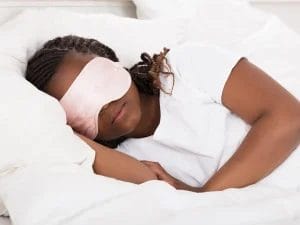Migraine, Seasonal Depression and SAD: Part II
In our last blog, Managing Seasonal Depression Part 1, we looked at the symptoms and impact of Seasonal Affective Disorder. Today, I’d like to share my personal SAD plan in hopes that it might help others experiencing seasonal depression to talk with their doctors about creating their own plans.
As I mentioned in Part 1, daily, consistent self-care is key. Taking care of your physical body is so important during the darker months. Focusing on the following has helped me manage SAD, but it is also beneficial for migraine and other chronic conditions.
Taking Care of the Body
1. Movement
 Gentle, daily movement boosts endorphins and makes your brain happier. It’s a highly effective way to manage anxiety and depression and can make us physically feel better. It’s also one of the most difficult things to do when we are feeling low energy or are in pain. But it doesn’t have to be a hardcore sweat session—a quick walk around the block, some easy stretching or yoga, and even cleaning counts! You will feel the benefits even with just a few minutes of low to moderate activity, but consistency is key.
Gentle, daily movement boosts endorphins and makes your brain happier. It’s a highly effective way to manage anxiety and depression and can make us physically feel better. It’s also one of the most difficult things to do when we are feeling low energy or are in pain. But it doesn’t have to be a hardcore sweat session—a quick walk around the block, some easy stretching or yoga, and even cleaning counts! You will feel the benefits even with just a few minutes of low to moderate activity, but consistency is key.
Where I live here in Chicago, winters are COLD, but I try to bundle up and walk any day the sun is shining. Even if it’s just for a few minutes. Most days I do a short indoor workout at home. Rebounding (low bouncing on a mini trampoline) is my personal favorite because it’s low impact with full-body health benefits—and it’s fun!
You can read more about the benefits of exercise and tips for getting moving here.
2. Exposure to Light
The lack of sunshine during the fall and winter months can leave us feeling down and sluggish. Getting daily exposure to light is important for regulating our circadian rhythms and helps us maintain a healthy sleep-wake cycle. I try to expose my eyes to early morning light as close as possible to the time I wake up. A quick walk around the block or even just standing or sitting near a window where natural light comes in can help.
Natural light is best, but for those of us who live in places where sunlight is minimal during the winter months, light therapy can be a highly effective SAD treatment. This can be tricky for those with migraine as we so often experience photosensitivity. But you can tolerate light, a UV-free light therapy lamp may help. I personally use this one. Start out slow, using the lamp for just 5 minutes to make sure you have no adverse reactions. If you can tolerate it, you can build up the time you use it. I like to turn it on while I’m having my morning coffee, reading or working at my computer. You can do other things while the lamp is on, as long as your eyes are open and in the general direction of the light.
3. Good Sleep Hygiene
 The change in season can disrupt the balance of the body’s level of melatonin, which plays a role in sleep patterns and mood.[1] Getting daily movement and natural light can help regulate our sleep cycles. A consistent sleep schedule is always important, but even more so during the winter months. I go to sleep and wake up at the same time every day, even if I would love to sleep in. I shoot for 7-9 hours of quality sleep each night and try to avoid daytime naps. This is hard because I LOVE naps, but they negatively impact the quality of my nighttime sleep during the winter months. On days where I’m feeling really low energy, I try a 20-minute power rest, often while using my CEFALY device on the preventive setting.
The change in season can disrupt the balance of the body’s level of melatonin, which plays a role in sleep patterns and mood.[1] Getting daily movement and natural light can help regulate our sleep cycles. A consistent sleep schedule is always important, but even more so during the winter months. I go to sleep and wake up at the same time every day, even if I would love to sleep in. I shoot for 7-9 hours of quality sleep each night and try to avoid daytime naps. This is hard because I LOVE naps, but they negatively impact the quality of my nighttime sleep during the winter months. On days where I’m feeling really low energy, I try a 20-minute power rest, often while using my CEFALY device on the preventive setting.
Read more about the importance of sleep and get tips for regulating your sleep cycle here.
4. Nutrition
Maintaining a well-balanced diet is critical to overall health and well-being, and this is even more important for people who live with chronic health conditions. Since low levels of vitamins D, B and omega-3s have been linked with depression, supplementing and eating foods high in those vitamins may help us feel better. [2] Avoiding too many processed carbohydrates can also help.
One of my favorite ways to boost my nutrition this time of year is by making soups. I pack them full of vegetables and healthy proteins and freeze leftovers for a quick future meal. I look for simple recipes that have only a few fresh ingredients and are easy to pull together in the crock pot or instant pot.
Read more about nutrition and migraine management here.
5. Hydration
Staying hydrated during the winter months is so important, especially for those of us with migraine. But it can be difficult to drink as much as we need, especially if we are cold or don’t feel as thirsty. At this time of the year I like to add some warm drinks to my daily routine—think decaffeinated hot teas, or hot water with lemon and honey. These not only help keep me hydrated, but also give me an opportunity to build a cozy winter ritual into my day.
I hope sharing my plan has been helpful in giving you some ideas that will help you take care of your body during these winter months. In the next blog, Part 3: Managing Seasonal Depression, Taking Care of the Mind, I’ll share some tips for staying focused, motivated and present in the moment. These include ideas for being intentional with your time, leaning into the coziness and rest the season offers, and making time for creativity, connection and fun.